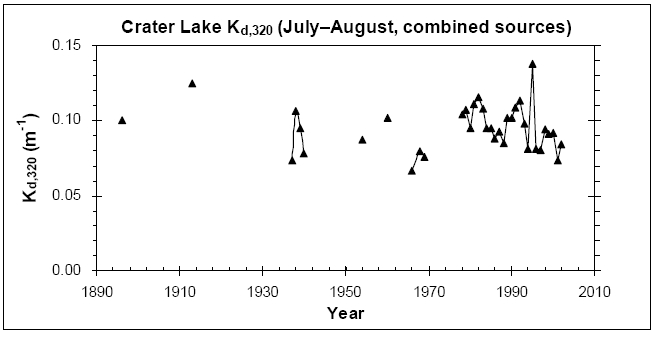Ultraviolet Radiation and Bio-optics in Crater Lake, Oregon, 2005
DISCUSSION
Decadal Changes in UV Transparency
Comparisons of our UVR attenuation measurements with those from radiometer data in the 1960s and from frequent proxy measurements since 1978 suggest that UV attenuation changes on decadal and longer cycles, perhaps in response to a combination of rain and stratospheric ozone influencing the phytoplankton community, with heavy summer rain occasionally influencing the level of suspended mineral particles. We also cannot rule out the impact of trophic interactions and winter precipitation or nutrient upwelling as additional factors influencing phytoplankton. Given the modest level of variation that our phytoplankton model accounts for, it is also possible that substantial variations in attenuation are caused by wind-driven changes in suspended mineral particles during dry periods. One possible explanation for lower average blue attenuation since 1992 (excluding storm-related peak in 1995) is the improvement to sewage disposal at the tourist facilities in 1991 (Larson 2002). This hypothesis is considered unsupported by phytoplankton data by McIntire et al. (this issue), and is also not supported by optical measurements once the pattern of rising attenuation in the early 1980s is placed into a longer time context (Figure 16B). Climate variation is another likely factor to explain changes in blue and UV attenuation, possibly linked through periodic winter upwelling events that are thought to provide the majority of nutrients to phytoplankton each year (Larson et al., 1996a; McManus et al., 1993). Redmond (1999) reported a shift in prevailing winds in the mid-1970s over the region that was associated with the Pacific Decadal Oscillation (PDO, Mantua et al., 1997). The sparse attenuation estimates from proxy data since 1896 fall within the range of the better characterized period since 1978, and from these we conclude that there has been no long-term change in UV transparency since 1896.
***previous*** — ***next***


